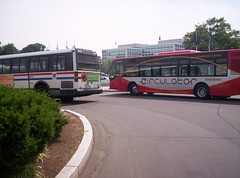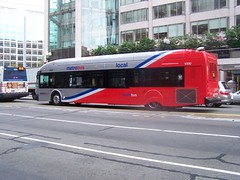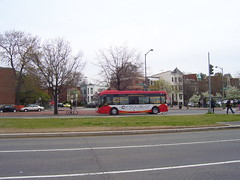(Ir)rational planning #2: sexy (Circulator) vs. plodding (Metrobus) bus service
Georgetown Metropolitan reports in "Circulator to No Longer Ascend Wisconsin?," that the Circulator bus route up and down Wisconsin Avenue north of M Street is in danger of being cut.
Umm, that's fine.
The frequency of bus service on a specific route is directly related to the number of passengers using the route. Routes that exhibit high ridership should be provided frequent service, whereas routes with low ridership should be provided less frequent service.
-- from the journal article "Produtivity Frequency Index, Journal of the Transportation Research Board, 1997. (For another perspective, see the journal article "The Dynamics of Fare and Frequency Choice in Urban Transit," which calls for a better balancing of fares and frequency, making the point that more frequency can come at the expense of higher bus fares or subsidies, and this class lesson, (Bus) Costs and Service Planning Practice.)
That stretch of Wisconsin Avenue north of M Street has service from the 30s Metrobus line plus the Circulator. For most of the day, there is a minimum of 5-8 buses/hour on the 30s line there. Unless the Circulator is running 10,000 passengers/daily on the stretch, the duplication of the service is "unwise" and definitely wasteful.
A problem with bus service planning in DC over the last couple years is that in part it has shifted from focusing on ridership levels and service frequency to the design and type of bus.
The Circulator buses have a great design, and they are supposed to come every 10 minutes, meaning you don't have to rely on a schedule.
(Note that the new livery scheme for Metrobuses is really quite nice and competitive with the Circulator, even if Metrobus could do better still.)
Old Metrobus livery vs. DC Circulator Bus (at Union Station)

New Metrobus design

Still, the extension of the DC Circulator bus, with 10 minute headways (6 buses per hour) to Capitol Hill and to Columbia Heights, is a mistake, despite the fact that other bloggers have written about it positively.
Unless a bus route has a minimum daily ridership of at least 10,000 people, service levels of six buses/hour aren't justifiable. The route that the Capitol Hill Circulator has replaced had fewer than 2,000 daily riders. I imagine that the ridership levels are comparable today. Make the buses prettier sure, but don't provide more service than is justifiable. This only increases costs with little in the way of practical return.
Even though the Columbia Heights Circulator bus has decent ridership (a few thousand people daily, but I am not sure of the exact number) in some respects this is merely poaching from other routes on 14th Street. Plus, this route has a long stretch--from U Street to McPherson Square--where it runs with no stops. Instead, the route should stay within the U Street-Columbia Heights-Adams Morgan-Woodley Park area. But again, the route this bus replaced (the Adams Morgan Link) was the least effective most expensive bus route in the WMATA system.

The Circulator buses on the routes in Columbia Heights and Capitol Hill are 30 feet long, not 40 feet long, in recognition that ridership levels wouldn't justify the use of a 40 foot bus.
Rather than call it a day, DC is now paying for this separate, somewhat ill-conceived bus route, but with fancy new buses and more frequent service.
When resources are put into providing a high level of service on a route where ridership doesn't justify it, this comes at a cost to service and/or transit budgets in other areas with potentially greater need and/or demand.
Don't get me wrong, I do favor intra-neighborhood bus services (see the definition of tertiary bus service in this blog entry, "Thinking about the transit network,") but they have to be well conceived, with justifiable service profiles.
Otherwise, we end up making bad choices, bad decisions, and wasting money.
In the meantime, more and more people, because of the sexy livery of the Circulator, think it's a great success, advocating for expansion of "Circulator" bus service in more and more places in the city, without recognizing the truth that the expansion is occurring for nonpolitical reasons, when in reality, expansion is a sign more of manipulation than of success.

Better marketing for transit is an absolute necessity, especially for bus service. But just because a bus service is marketed better than other bus services in the region, it doesn't necessarily mean in any and all cases that the better marketed bus service is actually better.
Labels: electoral politics and influence, transit, transit economics, transportation planning



0 Comments:
Post a Comment
<< Home